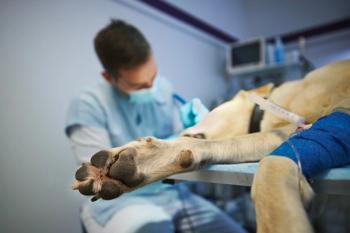
Seizures: etiologies and developing a diagnostic plan (Proceedings)
The clinical manifestation of excessive and/or hypersynchronous neuronal discharge within the brain; may be manifested as episodic impairment or loss of consciousness, abnormal motor phenomena, psychic or sensory disturbances, or autonomic signs such as salivation, vomiting, urination or defecation. Synonyms – convulsion, ictus, fit.
Definitions
Seizures are an important clinical problem in both dogs and cats and account for a substantial proportion of admissions to both general and referral veterinary hospitals. Although most veterinarians are very familiar with seizures, it helps to define this term explicitly as follows:
Seizure
The clinical manifestation of excessive and/or hypersynchronous neuronal discharge within the brain; may be manifested as episodic impairment or loss of consciousness, abnormal motor phenomena, psychic or sensory disturbances, or autonomic signs such as salivation, vomiting, urination or defecation. Synonyms – convulsion, ictus, fit.
Seizures have been classified in the past according to the areas of the brain that they affect. Thus, they have been termed generalized or focal (partial) seizures, defined as follows:
Generalized
abnormal electrical discharges affecting the cerebral hemispheres bilaterally and typically causing symmetric signs. Several manifestations are possible, including generalized tonic-clonic ("Grand mal"), or exclusively tonic, clonic or atonic activity.
Focal (partial)
abnormal electrical discharges of neurons in a focal area of the brain; may result in asymmetric motor or sensory signs such as twitching of the eyelids, lips, ears or one limb. Focal seizures may secondarily generalize to involve both hemispheres; that is, the electrical activity spreads across the cerebral cortex. This often gives rise to focal motor activity, which then evolves; this can often be recognized by owners.
Seizures vs. Seizure impostors
A number of other clinical conditions can mimic seizures, including syncope, acute vestibular dysfunction, tremors, narcolepsy/cataplexy, rapid eye movement (REM) behavior disorder, movement disorders (e.g., distemper myoclonus), and behavioral disorders. The majority of patients presenting for seizures are normal in the veterinary hospital, and the clinician's first task is to decide whether the events in question are true seizures, or seizure "mimics". Some guidelines for this determination follow:
• Seizures frequently involve alterations in consciousness and autonomic signs
• Most seizures occur when animals are at rest or sleeping; syncope and narcolepsy/cataplexy occur predominantly with exercise or excitement
• Animals with syncope and narcolepsy/cataplexy have brief episodes with loss of consciousness, but are usually normal on recovery. Animals with seizures and loss of consciousness usually have post-ictal alterations of mentation
• REM behavior disorder occurs during sleep, but the animal is normal when awakened/roused
• Vestibular dysfunction usually has characteristic signs including head tilt and nystagmus
• Animals with tremors, movement disorders, and behavioral disorders will have a normal mentation and level of consciousness
Differential diagnosis for seizures
Once the clinician is reasonably certain that the events are true seizures, differential diagnoses may be considered. These can be broadly categorized into extracranial and intracranial etiologies. A seizure disorder indicates dysfunction of the forebrain (cerebrum or diencephalon). Extracranial causes of seizures originate from outside the central nervous system, causing dysfunction in an otherwise normal brain, and include metabolic, nutritional and toxic causes. Intracranial etiologies cause structural alterations of the forebrain itself, and include degenerative, anomalous, neoplastic, inflammatory, infectious, idiopathic, and traumatic causes.
Extracranial causes of seizures
• Hypoglycemia – main causes are juvenile hypoglycemia, hyperinsulinemia (secondary to insulin overdose or an insulin-secreting tumor), and sepsis.
• Hypocalcemia –causes include eclampsia, hypoparathyroidism and ethylene glycol intoxication.
• Hyponatremia – results from loss of sodium rich fluids (e.g. vomiting, diarrhea, diuretics), hypoadrenocorticism or increased water intake (psychogenic polydipsia).
• Hypernatremia – results from the loss of free water or sodium poor fluids (diabetes insipidus, excessive panting, high temperatures), decreased water intake (primary adipsia or limited access) or rarely through ingestion of high levels of salt.
• Hepatic encephalopathy – results from altered filtration of gastrointestinal portal blood by the liver. Main causes are the presence of an anomalous portosystemic shunting vessel or severe parenchymal hepatic disease with secondary shunting.
• Hypertriglyceridemia – primarily a disease of miniature Schnauzers, which have a congenital enzyme deficiency, allowing triglyceride accumulation in the blood.
• Nutritional disease – rare cause of seizures; historically thiamine deficiency has been implicated.
• Intoxication – a wide variety of toxins may lead to nervous system dysfunction and seizures. Examples include ethylene glycol, lead, heavy metals, metaldehyde, strychnine, and organophosphates.
Intracranial causes of seizures
• Degenerative disease – very rare causes of seizures; include lysosomal storage disorders and neuronal abiotrophies
• Anomalous conditions – hydrocephalus is the most common and occurs predominantly in toy and brachycephalic breeds. Less common conditions include epidermoid, dermoid, and arachnoid cysts, and lissencephaly.
• Neoplasia – common cause of seizures in older animals. Brain tumors may be primary (arise from brain itself) or secondary (metastatic or arise from adjacent structures [e.g., skull]). It is common to see seizures as the sole clinical sign of a brain tumor.
• Inflammatory disease – common cause of seizures in animals of any age. Encephalitis may be infectious (viral, fungal, protozoal, bacterial, rickettsial, or parasitic) or more frequently, non-infectious. Common non-infectious causes in dogs include granulomatous meningoencephalitis (GME) and necrotizing meningoencephalitis.
• Idiopathic disease – common cause of seizures – see below.
• Traumatic disease – seizures can occur immediately at the time of head trauma or as a late sequela after recovery.
Idiopathic epilepsy
Epilepsy is a chronic neurologic condition characterized by recurrent seizures, and has an intracranial origin. Idiopathic epilepsy denotes "a syndrome unto itself"; that is, a well-recognized clinical condition of recurrent seizures without other neurologic signs and without any identifiable underlying cause. It is considered to be an inherited or familial condition, although the details of the genetic transmission are unknown in veterinary medicine except for a few families of dogs. This is a controversial topic in cats, although in the author's opinion, no convincing data exists to support an inherited etiology in this species.
Seizures have generally been considered to be of the generalized tonic-clonic variety, although this may not always be the case. The seizures almost always begin between 1 and 5 years of age, although a few dogs may have an onset between 6 and 12 months or up to 7 years of age. One of the hallmarks of idiopathic epilepsy is its insidious onset; seizures initially occur weeks to months apart and gradually become more frequent. Many dogs progress to develop cluster seizures or status epilepticus. In rare cases, this may be the first known seizure activity. Although certain breeds of dogs are predisposed to the development of idiopathic epilepsy, this condition can probably occur in any dog.
In the absence of a genetic test, diagnosis is based upon an appropriate signalment and description of seizure onset and character, and by ruling out other potential etiologic diagnoses with appropriate tests (typically cerebrospinal fluid [CSF] evaluation and brain imaging). Outside of the ictal and immediate post-ictal periods, the neurologic examination should be normal.
Probably symptomatic epilepsy
This condition is synonymous with acquired epilepsy and cryptogenic epilepsy. It implies that an acquired structural lesion within the brain is suspected to be causing the seizures, but cannot be detected with the available diagnostic tests (e.g., patients with a previous intracranial disease such as head trauma or meningoencephalitis that have since recovered, but are left with recurrent seizures because of assumed scarring or fibrosis within the brain). Seizures may be focal, focal with secondary generalization, or generalized, and may occur at any age. All breeds of dog and cat can be affected. Although occasional focal neurologic deficits (e.g., reduced conscious proprioception on one side) are noted, the majority of these patients have a normal neurologic examination. The diagnosis is based on signalment, neurologic examination, and by ruling out other causes of seizures with appropriate diagnostic testing. Unless concerned about the potential for breeding a patient and passing on the trait, it is not that critical to differentiate probably symptomatic epilepsy from idiopathic epilepsy, as the treatment for both is identical.
Signalment and commonly associated etiologies
Less than 1 year of age
Head trauma, intoxication, hypoglycemia, meningoencephalitis, hepatic encephalopathy, hydrocephalus, lysosomal storage disease, other congenital disorders
From 1 to 5 years of age
Idiopathic epilepsy, probably symptomatic epilepsy, head trauma, intoxication, meningoencephalitis, hydrocephalus, hepatic encephalopathy, cerebrovascular disease, cerebral neoplasia
Greater than 5 years of age
Cerebral neoplasia, probably symptomatic epilepsy, meningoencephalitis, cerebrovascular disease, hypoglycemia
Diagnostic testing and plan
Diagnostic testing for seizures can be divided into three steps:
• Step 1 – CBC, serum biochemistry, urinalysis
• Step 2 – Thoracic and abdominal imaging, serum bile acids, toxin assays (e.g., cholinesterase, lead, ethylene glycol), infectious disease titers, skull radiographs
• Step 3 – CSF evaluation, computed tomography (CT) or magnetic resonance imaging (MRI), electroencephalography (EEG)
Step 1 should probably be performed on any patient with seizures. Step 2 consists of tests that are readily available to most veterinary practitioners and may be chosen in certain cases depending on the index of suspicion for a certain disease. Step 3 consists of specialized tests that specifically evaluate the nervous system, and are usually only available at specialty referral hospitals. The signalment, history and physical and neurologic examinations are critical when deciding which diagnostic tests are appropriate.
Important history questions to ask
Character, onset, frequency and progression of seizures; evidence of asymmetry; evidence of prodrome or post-ictal period, neurologic status between seizures, vaccination status and travel history, previous illness and medications
Important physical examination findings
Evidence of cardiovascular disease, evidence of hepatic disease, retinal (fundic) examination
Important neurologic examination findings
Altered mentation, focal cranial nerve deficits, circling or turning in one direction, focal postural reaction or conscious proprioceptive deficits, visual deficits, cervical hyperesthesia
When to choose step 3?
An important decision point is when to refer a patient with seizures to a specialty hospital to receive the tests listed above in Step 3. In the author's opinion, this may be considered in any animal with seizures where extracranial etiologies have been ruled out, if the owners are so inclined. However, other patient circumstances may increase the suspicion of an active intracranial process, and thus the urgency for referral. These include focal seizure activity, focal neurologic deficits, dogs less than 1 year or greater than 5 years of age, and all cats.
Newsletter
From exam room tips to practice management insights, get trusted veterinary news delivered straight to your inbox—subscribe to dvm360.






